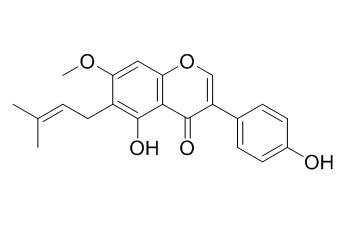Gancaonin G
Gancaonin G shows antibacterial effects on the MRSA strains with MIC values of 16 microg/ml, it also shows more moderate antibacterial activity against Streptococcus mutans.
Inquire / Order:
manager@chemfaces.com
Technical Inquiries:
service@chemfaces.com
Tel:
+86-27-84237783
Fax:
+86-27-84254680
Address:
1 Building, No. 83, CheCheng Rd., Wuhan Economic and Technological Development Zone, Wuhan, Hubei 430056, PRC
Providing storage is as stated on the product vial and the vial is kept tightly sealed, the product can be stored for up to
24 months(2-8C).
Wherever possible, you should prepare and use solutions on the same day. However, if you need to make up stock solutions in advance, we recommend that you store the solution as aliquots in tightly sealed vials at -20C. Generally, these will be useable for up to two weeks. Before use, and prior to opening the vial we recommend that you allow your product to equilibrate to room temperature for at least 1 hour.
Need more advice on solubility, usage and handling? Please email to: service@chemfaces.com
The packaging of the product may have turned upside down during transportation, resulting in the natural compounds adhering to the neck or cap of the vial. take the vial out of its packaging and gently shake to let the compounds fall to the bottom of the vial. for liquid products, centrifuge at 200-500 RPM to gather the liquid at the bottom of the vial. try to avoid loss or contamination during handling.
J Pharm Pharmacol.2024, 76(10):1239-1268.
Molecules2022, 27(9):2613.
Pest Manag Sci.2023, 79(8):2675-2685.
Integr Cancer Ther.2018, 17(3):832-843
Kor. J. Pharmacogn.2016, 47(1):62-72
Nutrients.2024, 16(20):3521.
Appl. Sci.2020, 10(8),2804
Foods2023, 12(23), 4342.
Clin Transl Med.2021, 11(5):e392.
Nutrients.2021, 13(3):978.
Related and Featured Products
J Nat Prod. 2006 Jan;69(1):121-4.
Antibacterial compounds from Glycyrrhiza uralensis.[Pubmed:
16441081]
METHODS AND RESULTS:
From the roots of Glycyrrhiza uralensis, two new pterocarpenes, glycyrrhizol A (1) and glycyrrhizol B (2), along with four known isoflavonoids, 5-O-methylglycryol (3), isoglycyrol (4), 6,8-diisoprenyl-5,7,4'-trihydroxyisoflavone (5), and Gancaonin G (6), were isolated using a bioassay-guided fractionation method. The structures of the new compounds (1and 2) were elucidated by spectroscopic data interpretation. The known compounds (3-6) were identified by comparison of their spectroscopic data with reported values in the literature.
CONCLUSIONS:
Glycyrrhizol A (1) and 6,8-diisoprenyl-5,7,4'-trihydroxyisoflavone (5) exhibited potent antibacterial activity against Streptococcus mutans with minimum inhibitory concentrations of 1 and 2 microg/mL, respectively, while glycyrrhizol B (2) and Gancaonin G (6) showed more moderate activity.
Chem Pharm Bull (Tokyo). 2000 Sep;48(9):1286-92.
Phenolic constituents of licorice. VIII. Structures of glicophenone and glicoisoflavanone, and effects of licorice phenolics on methicillin-resistant Staphylococcus aureus.[Pubmed:
10993226]
METHODS AND RESULTS:
Two new phenolic compounds, glicophenone (1) and glicoisoflavanone (2), were isolated from commercial licorice, and their structures were elucidated on the basis of spectroscopic data. Antibacterial assays of licorice phenolics for Staphylococcus aureus, including four strains of methicillin-resistant S. aureus (MRSA), and also for Escherichia coli K12 and Pseudomonas aeruginosa PAO1, were then examined. Two compounds among them, 8-(gamma,gamma-dimethylallyl)-wighteone (21) and 3'-(gamma,gamma-dimethylallyl)-kievitone (28), showed remarkable antibacterial effects [minimum inhibitory concentrations (MICs), 8 microg/ml on the MRSA strains and methicillin-sensitive S. aureus. Licochalcone A (14), Gancaonin G (20), isoangustone A (24), glyasperins C (30) and D (31), glabridin, (32), licoricidin (33), glycycoumarin (34) and licocoumarone (40) showed antibacterial effects on the MRSA strains with MIC values of 16 microg/ml. Effects on the beta-lactam resistance of the MRSA strains were also examined, and licoricidin (33) noticeably decreased the resistance of the MRSA strains against oxacillin, as shown by the reduction in the MICs of oxacillin (lower than 1/128-1/1000 in the presence of 8 microg/ml of 33, and 1/8-1/32 in the presence of 4 microg/ml of 33).
CONCLUSIONS:
Mechanistic study suggested that 33 does not inhibit the formation of penicillin-binding protein 2' (PBP2'), but affects the enzymatic function of PBP2'.
J Nat Prod. 2014 Mar 28;77(3):521-6.
Pyrano-isoflavans from Glycyrrhiza uralensis with antibacterial activity against Streptococcus mutans and Porphyromonas gingivalis.[Pubmed:
24479468 ]
METHODS AND RESULTS:
Continuing investigation of fractions from a supercritical fluid extract of Chinese licorice (Glycyrrhiza uralensis) roots has led to the isolation of 12 phenolic compounds, of which seven were described previously from this extract. In addition to these seven metabolites, four known components, 1-methoxyerythrabyssin II (4), 6,8-diprenylgenistein, Gancaonin G (5), and isoglycyrol (6), and one new isoflavan, licorisoflavan C (7), were characterized from this material for the first time. Treatment of licoricidin (1) with palladium chloride afforded larger amounts of 7 and also yielded two new isoflavans, licorisoflavan D (8), which was subsequently detected in the licorice extract, and licorisoflavan E (9). Compounds 1-9 were evaluated for their antibacterial activities against the cariogenic Streptococcus mutans and the periodontopathogenic Porphyromonas gingivalis.
CONCLUSIONS:
Licoricidin (1), licorisoflavan A (2), and 7-9 showed antibacterial activity against P. gingivalis (MICs of 1.56-12.5 μg/mL). The most potent activity against S. mutans was obtained with 7 (MIC of 6.25 μg/mL), followed by 1 and 9 (MIC of 12.5 μg/mL). This study provides further evidence for the therapeutic potential of licorice extracts for the treatment and prevention of oral infections.



